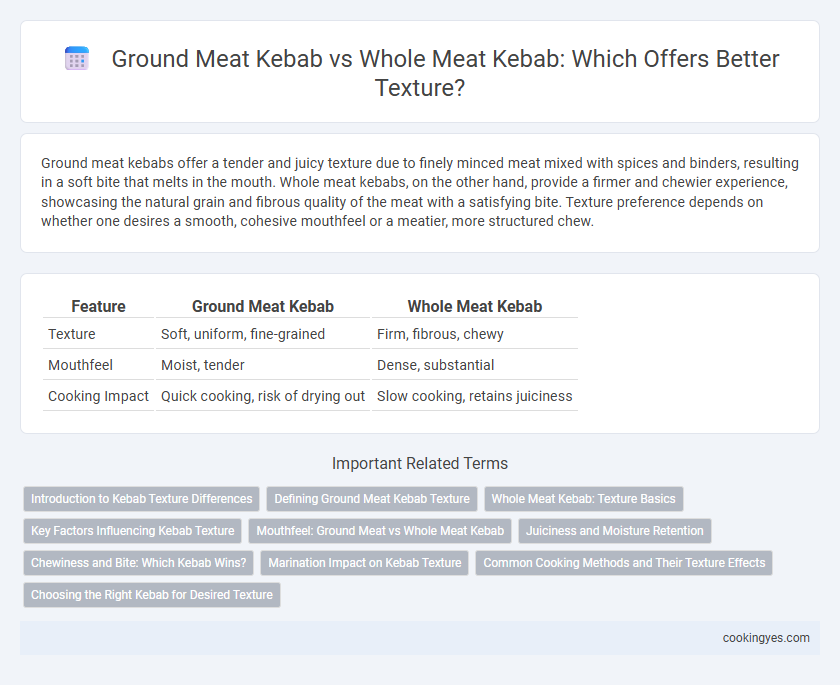Ground meat kebabs offer a tender and juicy texture due to finely minced meat mixed with spices and binders, resulting in a soft bite that melts in the mouth. Whole meat kebabs, on the other hand, provide a firmer and chewier experience, showcasing the natural grain and fibrous quality of the meat with a satisfying bite. Texture preference depends on whether one desires a smooth, cohesive mouthfeel or a meatier, more structured chew.
Table of Comparison
| Feature | Ground Meat Kebab | Whole Meat Kebab |
|---|---|---|
| Texture | Soft, uniform, fine-grained | Firm, fibrous, chewy |
| Mouthfeel | Moist, tender | Dense, substantial |
| Cooking Impact | Quick cooking, risk of drying out | Slow cooking, retains juiciness |
Introduction to Kebab Texture Differences
Ground meat kebabs offer a tender, cohesive texture that binds spices and fat evenly, creating a juicy and soft bite with consistent flavor distribution. Whole meat kebabs deliver a firmer, chewier texture, showcasing the natural grain and muscle fiber of the meat, resulting in a more robust and hearty mouthfeel. Texture preferences depend on the type of meat used, cooking method, and the desired balance between tenderness and chewiness in the final kebab experience.
Defining Ground Meat Kebab Texture
Ground Meat Kebab features a finely minced texture that ensures uniform cooking and a tender, juicy bite throughout. The grinding process allows spices and fat to blend thoroughly, creating a cohesive and smooth consistency. This contrasts with Whole Meat Kebab, where intact meat chunks deliver a chewier, more fibrous texture.
Whole Meat Kebab: Texture Basics
Whole meat kebabs offer a firmer and more distinct texture compared to ground meat kebabs due to the intact muscle fibers that provide chewiness and structural integrity. Grinding meat breaks down these fibers, resulting in a softer, more uniform texture often favored for juiciness but lacking the varied mouthfeel of whole cuts. The texture of whole meat kebabs depends on the cut used, with lean cuts delivering a denser bite and fattier cuts adding tenderness and moisture.
Key Factors Influencing Kebab Texture
Ground meat kebabs offer a uniform, tender texture due to the finely minced meat that binds easily with spices and fat, enhancing moisture retention and juiciness. Whole meat kebabs provide a firmer, chewier bite with distinct muscle fibers that create a more robust texture but require precise cooking to avoid toughness. Key factors influencing kebab texture include meat cut quality, fat content, marination time, and cooking method, all of which determine the final tenderness and flavor profile.
Mouthfeel: Ground Meat vs Whole Meat Kebab
Ground meat kebabs offer a tender, uniform texture with a juicy mouthfeel due to the finely minced blend, allowing spices and fat to distribute evenly. Whole meat kebabs provide a chewier bite and varied texture, retaining the muscle fibers that enhance the meat's natural chew and structural integrity. The choice between ground and whole meat kebabs significantly impacts the sensory experience, with ground meat delivering softness and moisture while whole meat emphasizes firmness and meatiness.
Juiciness and Moisture Retention
Ground meat kebabs offer superior juiciness and moisture retention due to the finely minced texture, which allows fat and juices to bind more effectively within the meat, creating a tender and succulent bite. Whole meat kebabs, while providing a firmer, more textured chew, tend to lose moisture more quickly during grilling, resulting in a drier finish compared to their ground counterparts. Choosing ground meat mixtures with optimal fat content, typically around 20%, enhances the juicy texture crucial for authentic kebab experience.
Chewiness and Bite: Which Kebab Wins?
Ground meat kebabs offer a uniform texture with a tender chewiness that melts in the mouth, ideal for those who prefer a softer bite. Whole meat kebabs boast a more robust, fibrous texture that requires a firmer bite, delivering a satisfying meatiness and distinct chew. For chewiness and bite, whole meat kebabs win by providing a more substantial and textured eating experience.
Marination Impact on Kebab Texture
Ground meat kebabs develop a tender, cohesive texture due to thorough marination that allows spices and acids to penetrate evenly, enhancing moisture retention and flavor absorption. Whole meat kebabs rely on marination to soften muscle fibers but retain a firmer bite and distinct meat grain, offering a chewier texture profile. Effective marination in ground meat typically involves longer soaking in yogurt or citrus-based mixtures to break down proteins, whereas whole meat benefits from enzyme-rich marinades applied for shorter durations to prevent surface toughening.
Common Cooking Methods and Their Texture Effects
Ground meat kebabs, often prepared by mixing minced lamb or beef with spices and herbs, yield a tender, juicy texture due to their fine consistency and moisture retention during grilling or pan-frying. Whole meat kebabs, typically made from marinated chunks of lamb or chicken, provide a chewier, more fibrous bite as the solid pieces retain muscle structure and develop a crispy exterior when cooked over direct heat such as charcoal grilling or broiling. Common cooking methods like skewering and high-heat grilling enhance the caramelization and textural contrast in whole meat kebabs, while ground meat kebabs benefit from even cooking and moisture infusion in techniques like pan-searing or oven-baking.
Choosing the Right Kebab for Desired Texture
Ground meat kebabs offer a tender, uniform texture due to finely minced meat blended with spices and binders, ideal for a juicy and cohesive bite. Whole meat kebabs retain a firmer, chunkier texture, highlighting the natural muscle fibers and providing a more robust, textured experience. Selecting ground meat kebabs ensures softness and moisture, while whole meat kebabs deliver a chewier, meatier sensation.
Ground Meat Kebab vs Whole Meat Kebab for Texture Infographic

 cookingyes.com
cookingyes.com